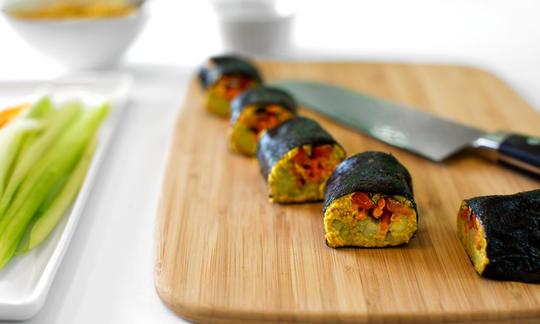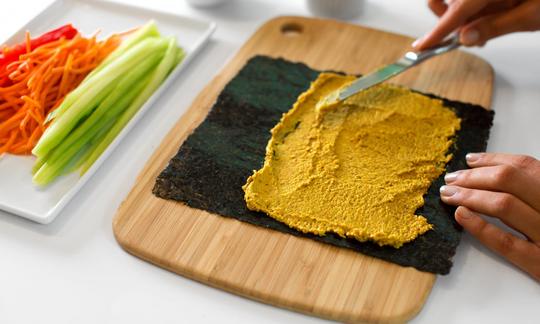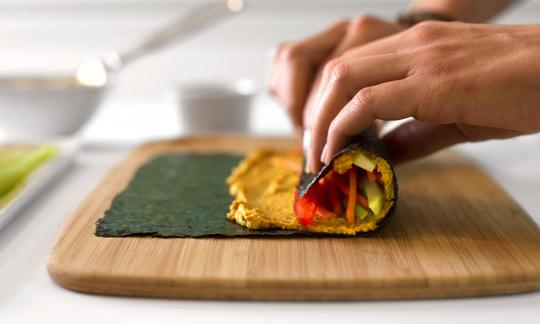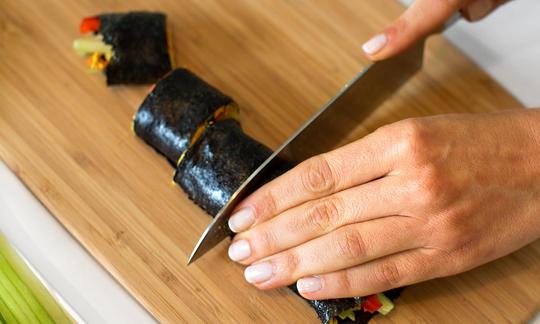Nori Rolls with Ginger Almond Paste and Raw Vegetables
raw-vegan
Ingredients (for servings, )
| For the ginger and almond paste | |
|---|---|
| 6 ⅔ oz | Almonds (sweet almonds), raw |
| 1 tbsp | Ginger, raw (organic?) (0.30 oz) |
| ½ tsp | Turmeric, fresh (raw, organic?) (0.04 oz) |
| 4 ⅓ oz | Carrots (carrots), raw (organic?) |
| ½ tsp | Sea salt (raw?, organic?) (0.09 oz) |
| 2 | Dates, variety Deglet Nour, pitted, raw?, (organic?) (0.50 oz) |
| 60 ml | Drinking water, raw (organic?) (2.1 oz) |
| For the nori rolls with vegetables | |
| 1 | Sweet peppers, red, raw (organic?) (5.8 oz) |
| 1 | Cucumbers, raw (organic?) (16 oz) |
| 4 ¾ oz | Yam beans (tuber bean, jícama, benkuang), raw, organic? |
| 4 | Nori sheets (raw? organic?) (0.37 oz) |
Equipment
- blender or hand-held blender / immersion blender or food processor
- spiralizer or vegetable peeler
- grater
Type of preparation
- chop or grind
- food preparation without heating
- soak
- meld
- purée
- grate (shred)
Preparation
For the ginger almond paste
Soak the almonds overnight and then drain.Grate or chop the ginger and turmeric root. Grate the carrots.
Purée the almonds, sea salt, dates, ginger, carrots, and turmeric root in a blender. Let the blender run as you slowly add the water. Continue to purée the mixture until it has the texture of a paste. It should be thick but spreadable. If necessary, add some more water (possibly up to about 80 ml).
A recipe for four servings yields about 220 g of the Ginger and Almond Paste.
For the nori rolls with vegetables
Cut the bell pepper and cucumber into very thin strips. Spiralize the jicama.Place a nori sheet with the shiny side down on a flat dry surface in front you. The narrower side should be closest to you. Spread one-fourth of the paste onto the nori sheet, leaving about one-third of the sheet free (the third that is farthest away from you). Place one-fourth of the vegetables horizontally on the paste so that they are about 5 cm away from the edge of the sheet.
You can use either raw or toasted nori sheets.
Starting at the side closest to you with the filling, roll up tightly. Moisten the top side of the nori sheet with water and then press down to seal.
Repeat for the remaining three rolls and then let the sushi briefly rest until they take on a somewhat softer consistency. This way the flavors can meld.
Serving
Cut each roll into about 5 pieces using a clean sharp knife. If desired, serve with a little tamari.The nori rolls can be stored overnight in the refrigerator. The ginger almond paste will keep for up to five days, which means that you could use it to make a second batch of rolls.
|
Nutritional Information per person
Convert per 100g
|
2000 kcal | |
|---|---|---|
| Energy | 359 kcal | 17.9% |
| Fat/Lipids | 25 g | 35.5% |
| Saturated Fats | 2.0 g | 9.9% |
| Carbohydrates (inc.dietary fiber) | 27 g | 10.0% |
| Sugars | 10 g | 11.2% |
| Fiber | 11 g | 42.6% |
| Protein/Albumin | 13 g | 26.6% |
| Cooking Salt (Na:300.9 mg) | 764 mg | 31.8% |
| Essential micronutrients with the highest proportions | per person | 2000 kcal | |
|---|---|---|---|
| Vit | Vitamin E, as a-TEs | 14 mg | 114.0% |
| Vit | Vitamin C (ascorbic acid) | 67 mg | 83.0% |
| Min | Manganese, Mn | 1.3 mg | 66.0% |
| Min | Copper, Cu | 0.62 mg | 62.0% |
| Fat | Linoleic acid; LA; 18:2 omega-6 | 6.1 g | 61.0% |
| Prot | Tryptophan (Trp, W) | 0.12 g | 50.0% |
| Vit | Riboflavin (vitamin B2) | 0.68 mg | 49.0% |
| Elem | Magnesium, Mg | 182 mg | 48.0% |
| Vit | Folate, as the active form of folic acid (née vitamin B9 and | 92 µg | 46.0% |
| Prot | Threonine (Thr, T) | 0.41 g | 44.0% |
Detailed Nutritional Information per Person for this Recipe
The majority of the nutritional information comes from the USDA (US Department of Agriculture). This means that the information for natural products is often incomplete or only given within broader categories, whereas in most cases products made from these have more complete information displayed.
If we take flaxseed, for example, the important essential amino acid ALA (omega-3) is only included in an overarching category whereas for flaxseed oil ALA is listed specifically. In time, we will be able to change this, but it will require a lot of work. An “i” appears behind ingredients that have been adjusted and an explanation appears when you hover over this symbol.
For Erb Muesli, the original calculations resulted in 48 % of the daily requirement of ALA — but with the correction, we see that the muesli actually covers >100 % of the necessary recommendation for the omega-3 fatty acid ALA. Our goal is to eventually be able to compare the nutritional value of our recipes with those that are used in conventional western lifestyles.
| Essential fatty acids | per person | 2000 kcal |
|---|---|---|
| Linoleic acid; LA; 18:2 omega-6 | 6.1 g | 61.0% |
| Alpha-Linolenic acid; ALA; 18:3 omega-3 | 0.03 g | 1.0% |
| Essential amino acids | per person | 2000 kcal |
|---|---|---|
| Tryptophan (Trp, W) | 0.12 g | 50.0% |
| Threonine (Thr, T) | 0.41 g | 44.0% |
| Phenylalanine (Phe, F) | 0.64 g | 41.0% |
| Isoleucine (Ile, I) | 0.44 g | 36.0% |
| Leucine (Leu, L) | 0.83 g | 34.0% |
| Valine (Val, V) | 0.51 g | 32.0% |
| Lysine (Lys, K) | 0.38 g | 20.0% |
| Methionine (Met, M) | 0.10 g | 11.0% |
| Vitamins | per person | 2000 kcal |
|---|---|---|
| Vitamin E, as a-TEs | 14 mg | 114.0% |
| Vitamin C (ascorbic acid) | 67 mg | 83.0% |
| Riboflavin (vitamin B2) | 0.68 mg | 49.0% |
| Folate, as the active form of folic acid (née vitamin B9 and | 92 µg | 46.0% |
| Vitamin A, as RAE | 334 µg | 42.0% |
| Vitamin K | 25 µg | 33.0% |
| Vitamin B6 (pyridoxine) | 0.31 mg | 22.0% |
| Niacin (née vitamin B3) | 2.9 mg | 18.0% |
| Thiamine (vitamin B1) | 0.19 mg | 17.0% |
| Pantothenic acid (vitamin B5) | 0.84 mg | 14.0% |
| Biotin (ex vitamin B7, H) | 2.8 µg | 6.0% |
| Essential macroelements (macronutrients) | per person | 2000 kcal |
|---|---|---|
| Magnesium, Mg | 182 mg | 48.0% |
| Phosphorus, P | 292 mg | 42.0% |
| Potassium, K | 807 mg | 40.0% |
| Sodium, Na | 301 mg | 38.0% |
| Calcium, Ca | 196 mg | 25.0% |
| Essential trace elements (micronutrients) | per person | 2000 kcal |
|---|---|---|
| Manganese, Mn | 1.3 mg | 66.0% |
| Copper, Cu | 0.62 mg | 62.0% |
| Iron, Fe | 3.1 mg | 22.0% |
| Zinc, Zn | 2.2 mg | 22.0% |
| Iod, I (Jod, J) | 10 µg | 7.0% |
| Selenium, Se | 2.8 µg | 5.0% |
| Fluorine, F | 32 µg | 1.0% |
These raw nori rolls are easy to make. The ginger and almond paste is a very flavorful alternative to the traditional rice filling.
Jicama: These edible roots are firm, crisp, and juicy. They have a sweet flavor that is reminiscent of apples. Jicama is originally from Mexico, but today it is grown in Africa and Asia. The roots are almost completely fat-free. The seeds can also be used; however, they aren’t edible and are instead used as insecticide.
Nori: Nori are sweet-tasting, paper-thin toasted or dried edible sea vegetables. The green nori that you can buy at the grocery store to make sushi has been toasted. Most nori is produced at special cultivation sites in Japan and Korea, where it contributes considerably to the economy. It is important to eat nori in moderation as it can contain a comparatively high amount of iodine.
Iodine and seaweed: It is important to always check how much iodine seaweed contains. Iodine is an essential trace element that is usually present in the form of iodide and is essential for the production of thyroid hormones. A lack of iodide can lead to hypothyroidism, and conversely consuming too much can burden the thyroid and be harmful to your health. The amount of iodine contained in seaweed varies depending on the type, harvest time, habitat, and processing methods used.
Storage: The nori rolls can be stored overnight in the refrigerator. The ginger almond paste will keep for up to five days, which means that you could use it to make a second batch of rolls.
Peeling jicama: You can use a potato peeler to peel the jicama, but you should make sure to remove all of the skin because it isn’t edible and can cause abdominal pain.
Turmeric stains: If you are using fresh turmeric root, you should wear gloves as turmeric can stain your hands. It can also stain light-colored kitchen appliances.
Zucchini: Instead of jicama, it also works well to use zucchini.
Ground ginger: If you don’t have fresh ginger, you can use ground ginger (½ teaspoon for 4 servings). However, fresh ginger is always preferable.
Filling: If you are preparing this dish for guests and will be using larger amounts of ingredients, it is nice to be a bit creative. Mushrooms (shiitake or oyster mushrooms) or green asparagus are nice additions.









